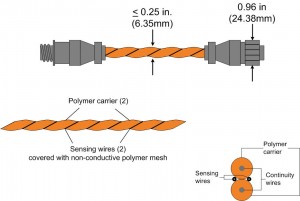Leak Detection Sensing Cable & Spot Detectors – How Are They Different?
When you offer great products, sometimes it’s difficult for your customers to make decisions. We run into that problem at RLE, and it’s a lucky problem to have. One of the questions we address most often?
“Spot detectors or sensing cables – how do I know which one to use in my facility?”
Since we’re the leak detection experts, we’re happy to answer that question for you.
- Spot detectors are designed to find leaks in focused locations. The base of a spot detector has two probes. In order for a leak to be detected, water must touch both the probes at the same time, which completes a circuit and triggers an alarm. If a spot detector is going to locate a leak, it must be placed where you believe a leak may occur, or where water will run or pool when a leak happens. For these reasons, spot detectors are ideal for drain pans, floor drains, pits and other confined areas. Spot detectors work best with zone leak detection controllers, that indicate a general area where a leak is present.
- Leak detection cable is designed to find leaks in more expansive areas, where the path of a leak may not be easy to predetermine. Leak detection cable is ideal for open areas, and can be used to encapsulate areas of concern. Leak detection cable can even be affixed directly to water supply and return lines. RLE water leak detection cable is ideal for larger surface areas with multiple leak points.
In application, creating a sensing cable that is reliable and durable is quite complicated. The cable needs to be flexible enough to bend, but rigid enough to maintain its shape, so the sensing wires are not compressed. The sensing wires need to react quickly but they should also be protected, so they do not become coated with dust and dirt that will cause false alarms. Our cable’s abrasion-resistant polymer core increases its strength and durability while the sensing wire is wrapped with a non-conductive polymer weave, protecting it from contamination. At RLE, we design our sensing cable to be accurate, durable, easy to clean, fast drying, and able to resist damage from most contaminants, which prevents common false alarms.
Leak detection sensing cable works well with both zone and distance-read leak detection controllers. Distance-read controllers provide additional advantages – they work with our resistance-based cable to pinpoint the location of a leak.
Our sales and support staff are happy to answer any leak detection questions, and will help you find the leak detection solution that best suits your needs. Contact us any time at [email protected] or [email protected].
Leave a Reply

